Free download: Top 10 Natural & Easy Remedies for Joint Pain from Home. Learn these helpful remedies.
A sprained knee can be quite a challenge to recover from if the appropriate steps aren’t taken in a timely manner.
A knee sprain has the potential to limit your ability to stand, walk, climb stairs, etc.
It’s important and helpful to know what a sprained knee is and how to most effectively heal it.
Table of Contents
What is a Knee Sprain?
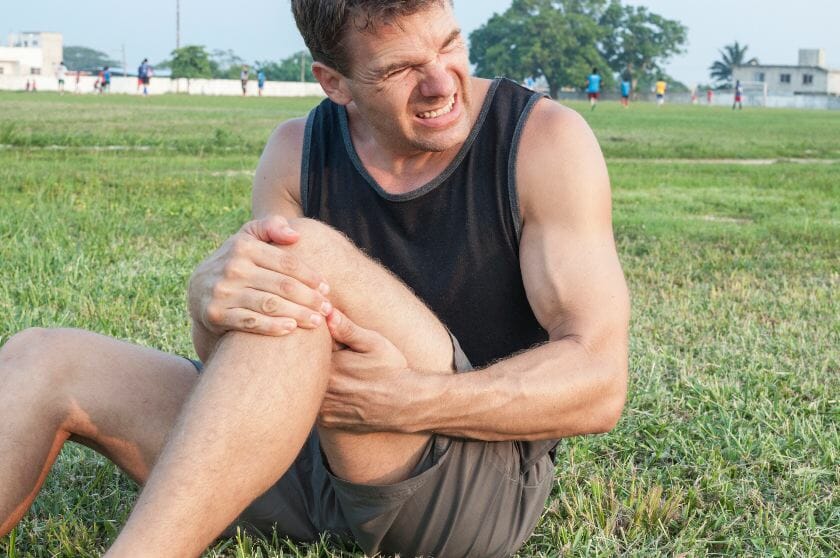
When you hear the term knee sprain, it means that one or more ligaments in the knee has been injured.
When a knee ligament is sprained, an abnormal amount of stress and load has been placed on it. This will typically over stretch and pull on the ligament fibers, which can create a partial or complete tear.
Grades of a Knee Sprain
Knee sprains can be categorized into three grades of severity. What the knee will feel like when sprained, depends on the grade of injury.
- Grade 1: This is the most mild type of knee sprain. The ligament has been overstretched, but is still able to provide enough support to the knee joint.There may be mild pain with this, but no noticeable movement limitations.
- Grade 2: This is a moderate severity of injury. There is a partial tearing of the ligament. You’ll likely begin to feel some instability, pain, swelling, and functional limitations. Use of crutches or a walker may be needed to help with walking.
- Grade 3: This is a severe sprain and a full tear. Pain, joint instability, swelling, and an inability to fully bear weight on the leg is normally present. Use of crutches or a walker may be needed to help with walking.
How Do You Sprain Your Knee?
To best understand what happens when you sprain your knee and how this occurs, it’s helpful to know what exact knee ligaments have the potential for injury. Different ligament injuries can have different mechanisms of injury.
The Ligaments of the Knee
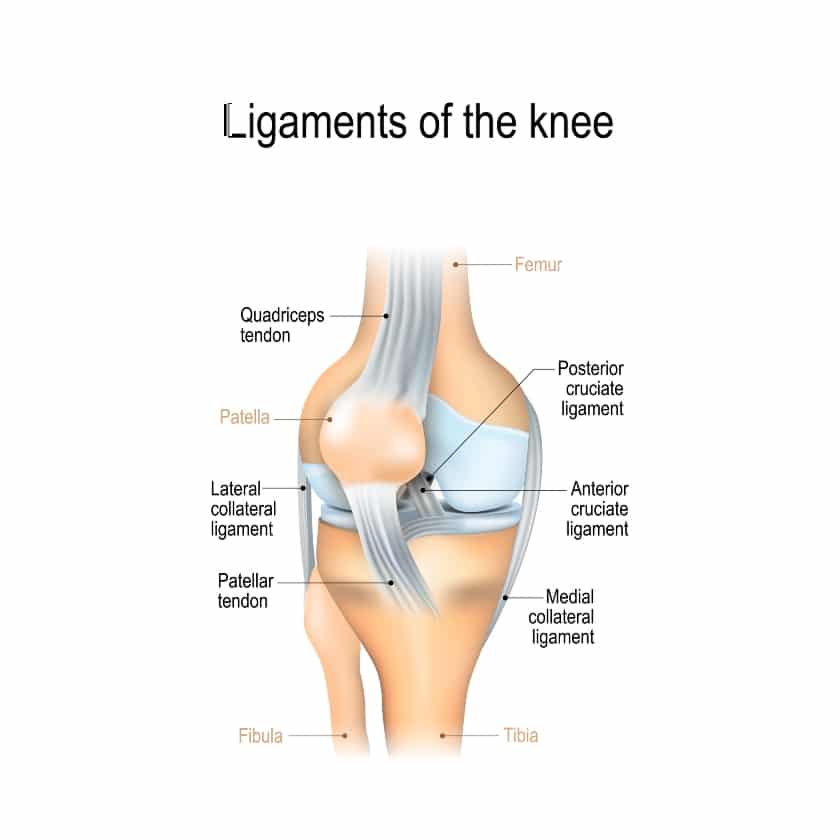
There are four ligaments that make up the knee. These four ligaments support and stabilize the knee joint:
- Anterior cruciate ligament (ACL)
- Posterior cruciate ligament (PCL)
- Medial collateral ligament (MCL)
- Lateral collateral ligament (LCL)
Anterior Cruciate Ligament
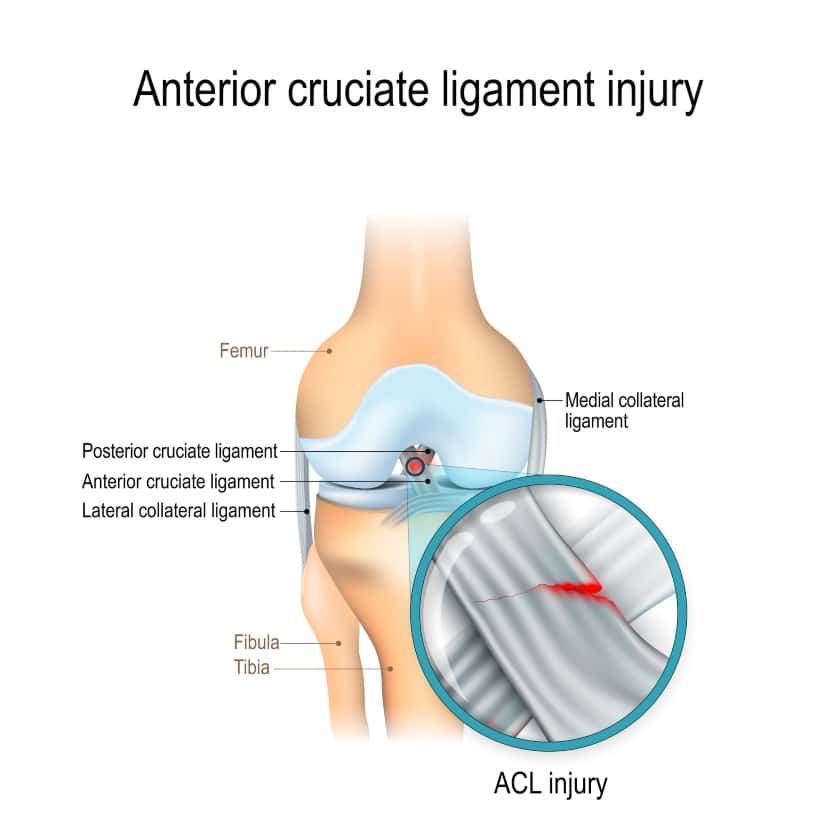
Location
The ACL is located within the knee joint itself, crossing in front of the PCL. It attaches to the end of the thigh bone and the top of the shin bone.
The ACL makes sure the tibia, or shin bone, doesn’t move or translate too far forward.
Causes of ACL injury
The ACL is most commonly injured during sports. This often occurs as a result of a sudden twisting or pivoting motion, or from a sudden, forced moment of knee hyperextension.
Other types of trauma can cause an ACL injury as well, such as a fall or car accidents.
Symptoms
Symptoms of an ACL knee sprain will usually include one or more of the following:
- Pain and swelling
- Popping sound
- Decreased range of motion
- Inability to bear weight on the leg
- The knee may feel unstable or as if it could give out
Posterior Cruciate Ligament
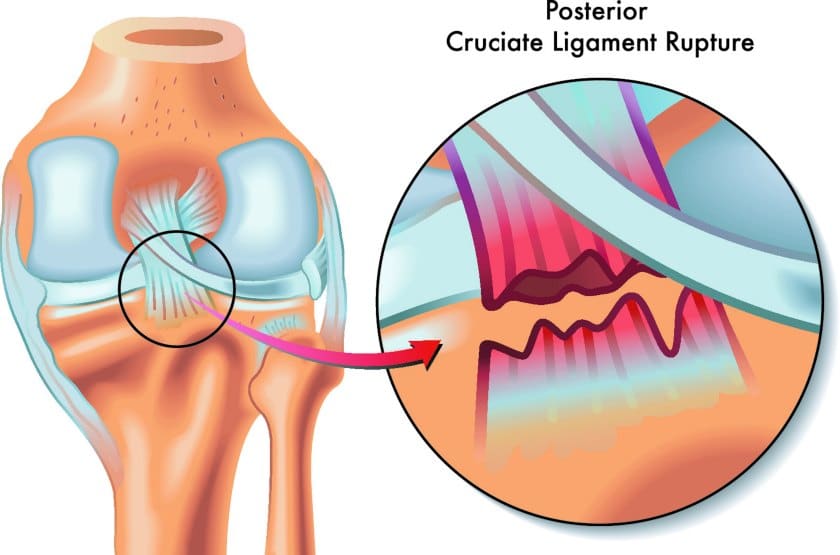
Location
The PCL is also located within the knee joint. It crosses behind the anterior cruciate ligament (ACL), also attaching to the femur, or thigh bone, and tibia, or shin bone.
The PCL prevents the shin bone from moving too far back. This ligament is not injured as often as the ACL as it’s considered a stronger ligament. Complete tears are not as common with the PCL as they are with the ACL.
Causes of PCL Injury
A PCL knee sprain often results from a direct, strong blow to the front of the knee.
This could happen falling onto the knee forcefully, if in a car accident with the knee resting on the dashboard, or could also occur from a twisting or hyperextension injury.
Symptoms
Symptoms of a PCL knee sprain can include one or more of the following:
- Pain and swelling
- Knee stiffness
- Unsteady knee or the feeling it may give out
- Trouble walking
Medial Collateral Ligament
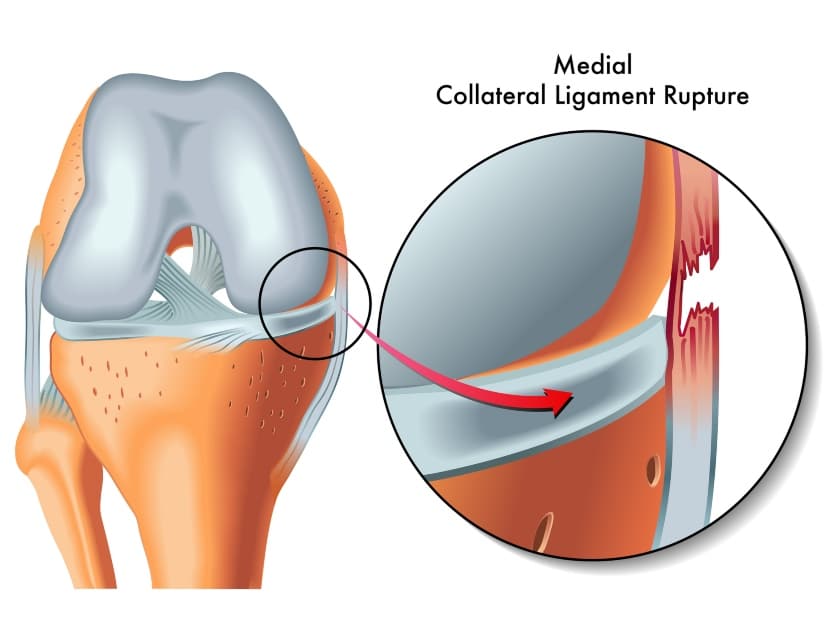
Location
The MCL is located on the inside, or medial portion, of the knee. It helps to keep the inner portion of the knee stable.
Causes of MCL Injury
MCL knee sprains are also common sports injuries. This usually occurs with a direct blow occurring to the outer side of the knee, placing too much stress and strain on the inside MCL ligament.
An MCL knee sprain can also occur if the knee twists inwardly while bent.
Symptoms
Common symptoms of an MCL sprain include the following:
- Tenderness on the inner, or medial, side of the knee
- Swelling
- Decreased knee flexibility
- Difficulty walking or limping
- You may hear a popping sound when the knee sprain occurs
- Knee stiffness
- Instability in the knee or the knee feeling as if it will buckle or give way
- The knee may feel like it’s locking or catching
Lateral Collateral Ligament
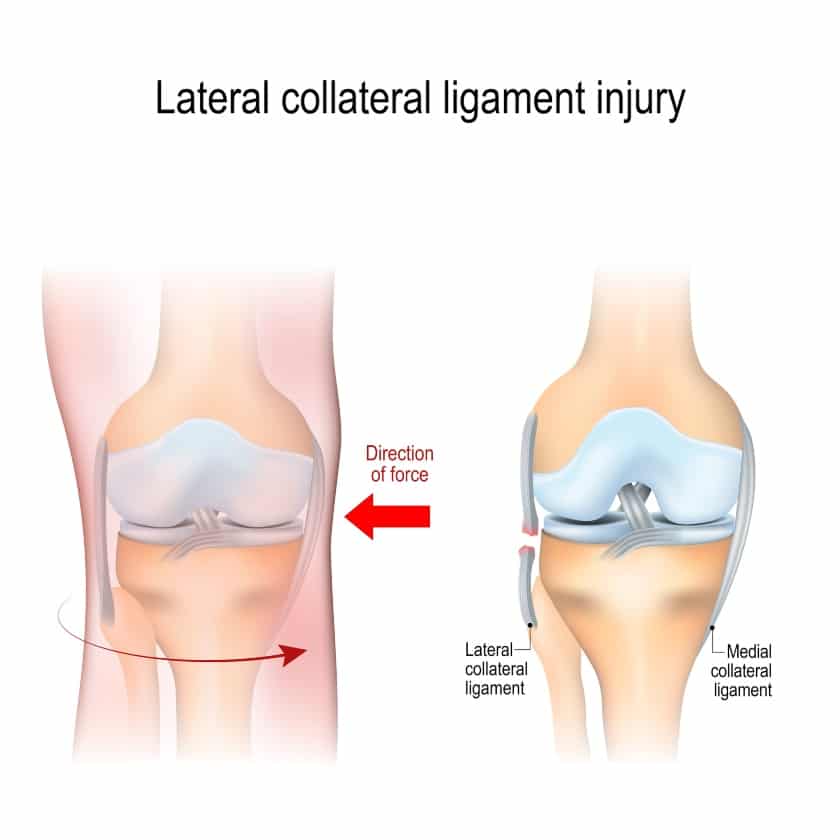
Location
The LCL is a knee ligament located on the outer side of the knee.
It supports the outside of your knee, preventing too much outer or lateral knee motion.
Causes of LCL Injury
An LCL knee sprain can also occur with sports, especially with a twisting motion towards the outside of the knee.
This injury can also occur if there is a direct blow or hit to the inside of the knee, causing excessive pressure and force towards the outer knee LCL.
Symptoms
The following symptoms are common with an LCL knee sprain:
- Tenderness on the outside of the knee
- Swelling
- Knee stiffness and knee pain
- Trouble walking or bearing weight on the leg
- The knee may feel unstable, and may try to lock or buckle
Different Phases of Healing
Treating a sprained knee depends on which phase of healing you’re in: the acute, subacute, or chronic phase of healing.
1. Acute Phase
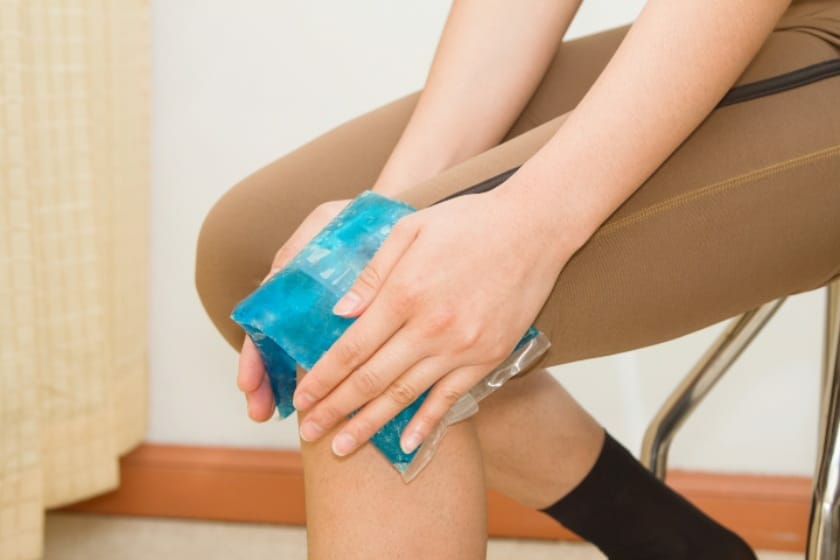
The acute phase occurs immediately after a knee sprain. In this phase, managing swelling and pain is essential.
The RICE method is highly utilized during this phase. This will involve the following:
- Rest the knee. Allow a few days of resting the knee. This doesn’t mean you need to lay in bed that whole time, but be gentle with your physical activity level to avoid further injury.
Make sure to keep the knee as supported as possible. Avoiding prolonging your resting period though, as this can delay your recovery time. - Ice the knee. To reduce swelling, frequently use an ice pack or a bag of crushed ice on your knee. You can ice the knee for about 20 minutes at a time.
- Compress your knee. Apply compression to the knee in the form of an elastic bandage, like an ACE wrap, or a knee brace. This can help the knee to feel more supported after an initial knee injury and reduce swelling.
- Elevate the knee. Keeping the sprained knee elevated in the correct position will help to control swelling and lessen pain. You can do this by propping a pillow or two under the injured leg.
Your doctor may also recommend anti inflammatory medications to help decrease pain and reduce inflammation.
Encouraging gentle knee range of motion and light muscle activation can be started in this phase. This will help with swelling, pain and to prevent stiffness in the knee.
2. Subacute Phase
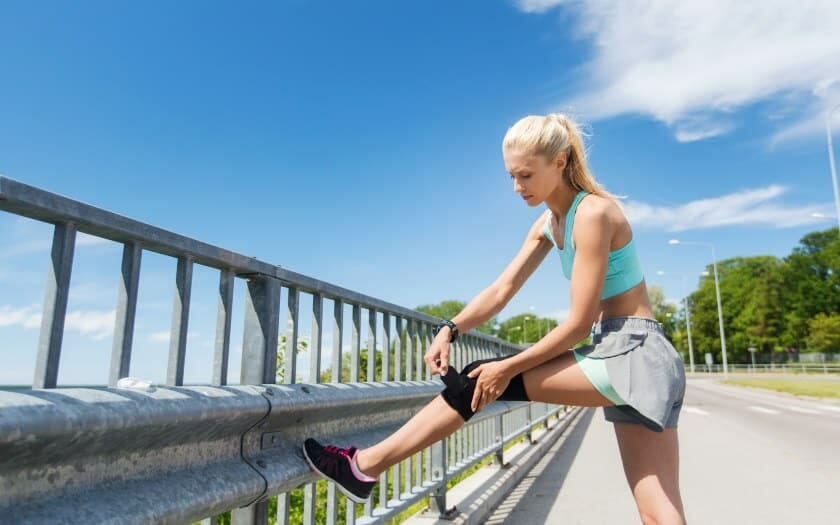
This phase will begin about 2 weeks after the initial knee sprain.
In this phase you will want to begin gradually increasing your activity level, but not so much that it worsens pain.
You won’t need to necessarily still use an elastic bandage in this phase, but sometimes wearing a knee brace while walking and increasing your activity level can help the knee feel more supported.
You’ll just want to make sure to gradually begin weaning your use of the brace, so that your own muscles and soft tissues are able to begin supporting the knee again.
3. Chronic Phase
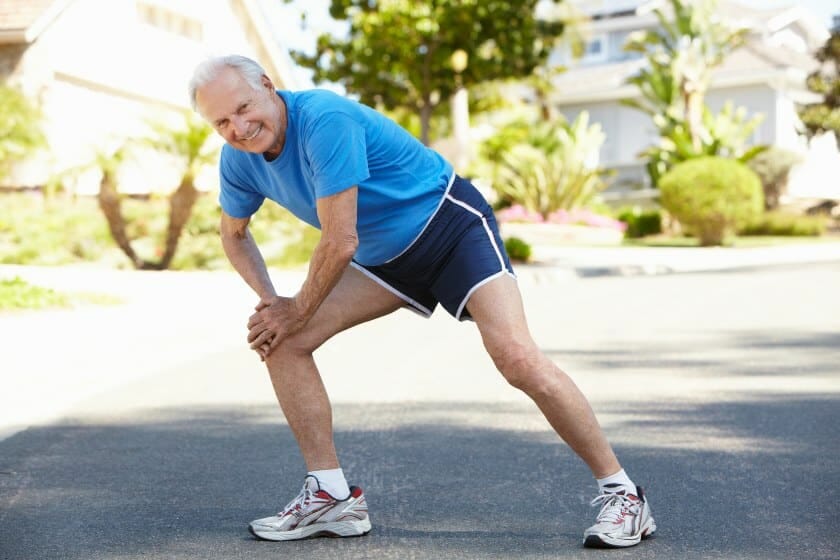
Ligament injuries become considered chronic knee injuries if symptoms continue for greater than 3 months.
This doesn’t mean your symptoms are permanent, but if you’re already in this phase and haven’t consulted with a healthcare provider or haven’t started any treatment for your knee sprain, then recovery time can be longer and more challenging to make a full recovery.
In this phase, pain and inflammation have usually reduced to where you can tolerate more advanced exercise and activity progression.
As in the subacute phase, try to wean reliance and use of a brace, so that your knee can learn how to support itself again.
Continue with gentle exercise progression in this phase.
How to Heal a Sprained Knee Quickly?
Treatment for a knee sprain should realistically begin immediately after the knee ligament injury.
Consult with an appropriate healthcare provider to confirm the diagnosis of the injured knee and receive the best professional medical advice.
You can consult with your primary care physician, an orthopedist or sports medicine specialist, and a physical therapist.
A. Physical Therapy: Exercises
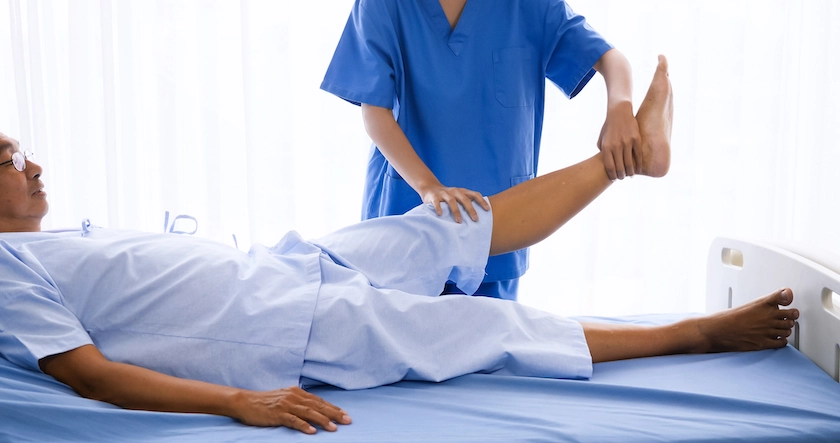
Mild sprains or partial knee ligament tears will usually be referred to physical therapy.
Your physical therapist will provide recommended exercises based on the limitations you demonstrate during the evaluation. The physical therapist may also include manual techniques and modalities to help with pain and inflammation.
Taping is commonly used during treatment to help provide initial support and stability while rehabbing the knee. While there are many ways to tape a knee sprain, depending on which ligaments have been injured, the video below will demonstrate a general taping method that can be used on the knee for additional support and stabilization.
A variety of exercises will be implemented to help the knee sprain recover in a timely manner. Factors such as phase of healing, pain level, available range of motion and strength, and functional limitations will determine which exercises are recommended.
Below is a few examples of common exercises used to rehab a sprained knee.
1. Quad Set
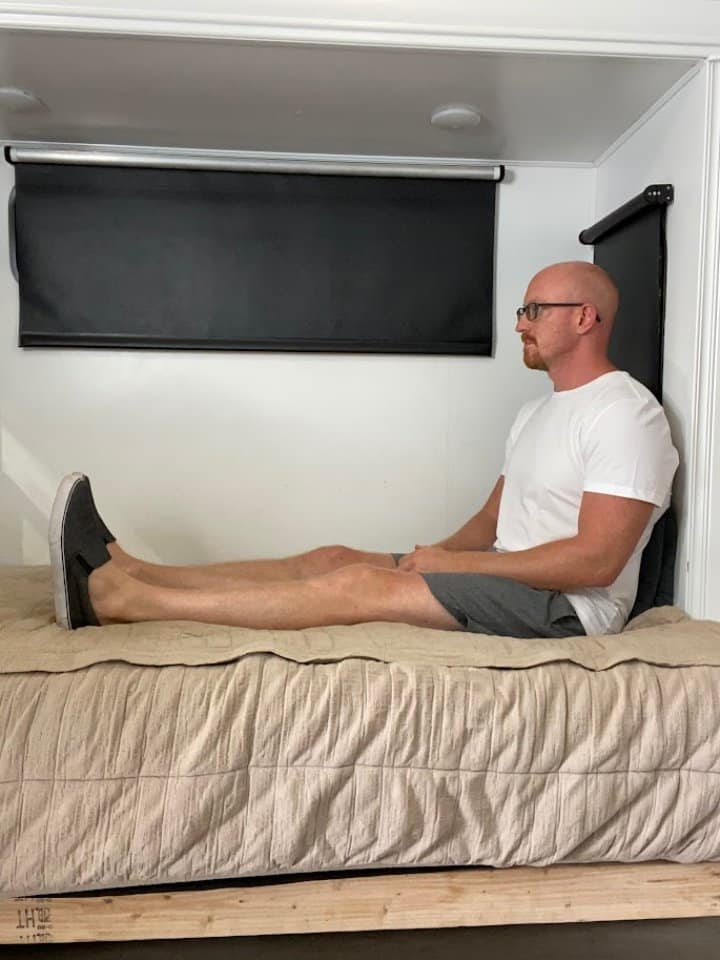
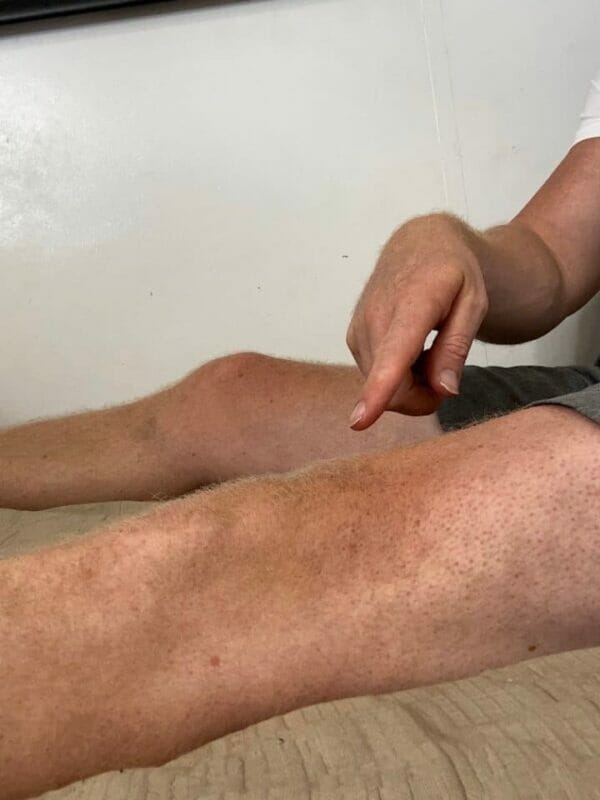
A quad set is a simple exercise that you can initiate in the acute phase for a knee sprain.
You can do this in a long sitting position, with your legs stretched out in front of you. You can be positioned on the floor, bed or couch.
- Gently press the back of the knee down towards the surface, squeezing the top of the thigh, or quad muscles, at the same time.
- Hold up to 5 seconds, then relax.
- Repeat 10-15 repetitions for 2-3 sets.
2. Bridge with Hip Abduction
This is an exercise appropriate for any phase of healing. It will activate the glutes and outer hip abductors. Strength in the hip muscles, such as these, will help to provide additional support and stability to the knee joint after a sprain.
- You’ll need a resistance band for this (light, medium or heavy resistance).
- Position yourself laying on your back with the knees bent and feet flat on the surface. This can be done on your bed, couch or the floor.
- Tie the resistance band around the thighs.
- Move the legs apart, slightly wider than hip width, to activate the outer hip abductors.
- Maintaining this resistance, lift the hips off the floor into a bridge to activate the glutes.
- Lower back down to the floor, but keep the tension with the band in place.
- Repeat 10-15 repetitions for 2-3 sets.
This combined motion can be a little challenging for your coordination at first, so take a look at this video providing a demonstration.
3. Long Arc Quad
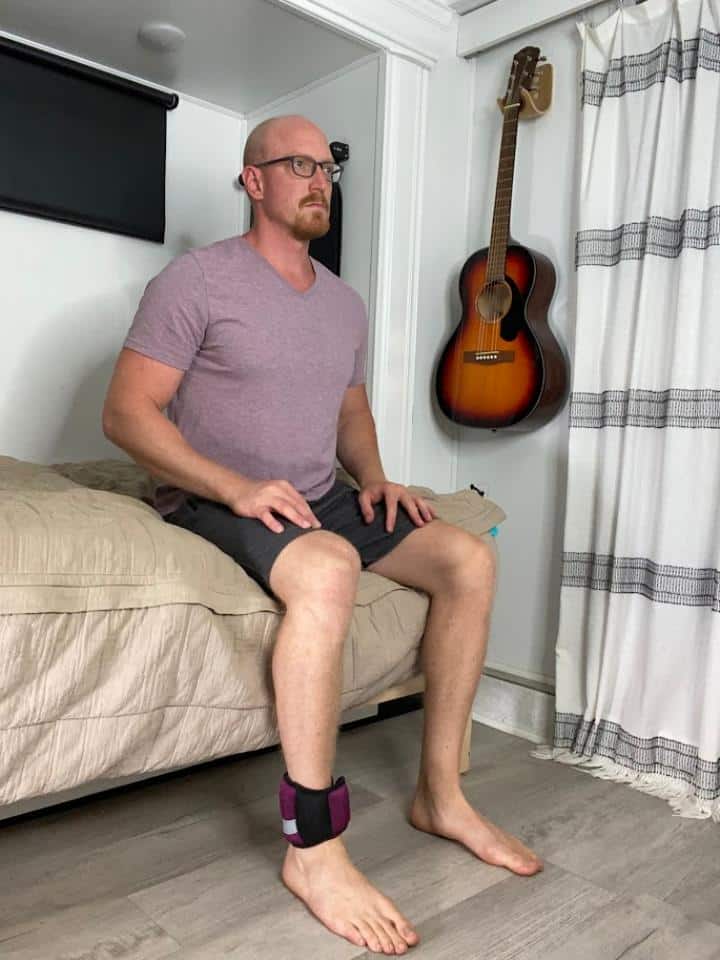
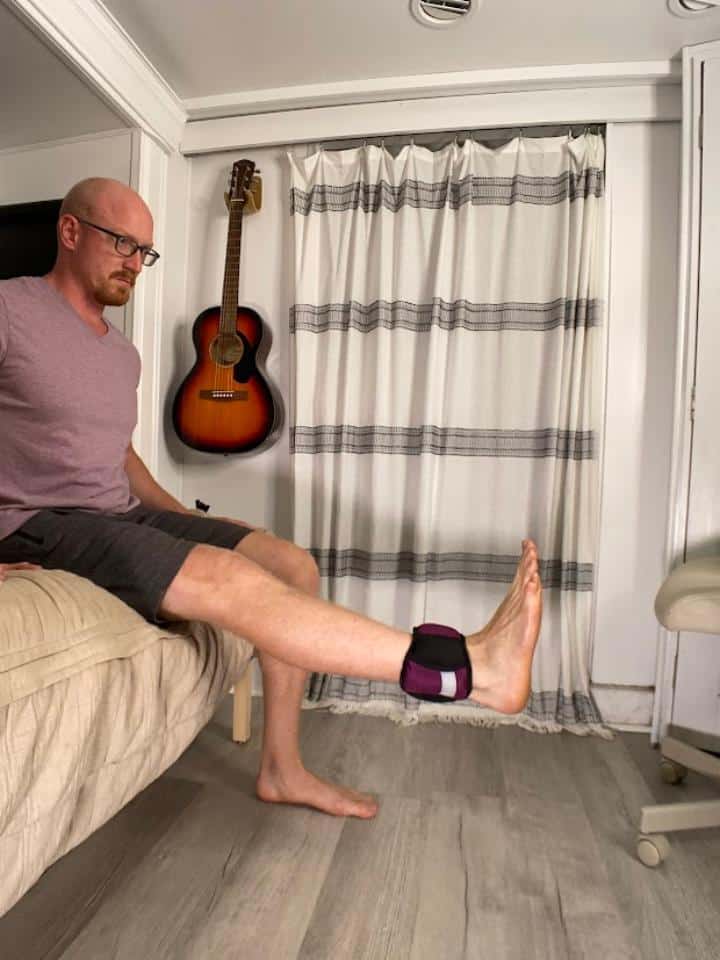
A long arc quad is good to introduce in either the subacute or chronic phase of healing. This will gently stimulate and challenge the quad muscles and is a progression from a quad set.
- Seated in a chair, tie a resistance band around the ankles (light, medium or heavy) or wrap a light ankle weight around the ankle on the affected leg (1-3#).
- Straighten the knee on the sprained side, while keeping the opposite foot planted flat on the floor.
- Hold for 2 seconds, then return to your starting position.
- Repeat 10-15 repetitions for 2-3 sets.
4. Mini Squat with Hip Abduction
This is another exercise working a combination of muscle groups, including the quads, hip abductors, and glutes.
- You’ll use a resistance band again for this one (light, medium, or heavy resistance).
- Tie the band around the thighs while the feet are together.
- Next, move the feet apart about hip width, which should place tension on the band and activate the hip abductors.
- From this position, move into a small, mini squat. Slowly bend the knees to about a 30-45 degree angle, sitting the hips back towards the heels.
- Hold for about 2 seconds, then return to your starting position.
- Repeat 10-15 repetitions for 2-3 sets.
Similar to the bridge with hip abduction, this can be a little challenging to coordinate at first. Check out the video below, which will provide a demonstration.
It’s not a bad idea to rest and apply ice to the sprained knee after you practice your exercises. This will help with pain and soreness, further speeding up the recovery time.
B. Surgery
Surgery is more commonly indicated for Grade 3 knee sprains, or a complete ligament tear.
This may require ligament repair or reconstruction, depending on the extent of injury and what the surgeon feels would allow best recovery for you.
An orthopedic surgeon will be the best healthcare provider to consult with to determine if surgery is appropriate and necessary for your particular injury.
How Long Does a Sprained Knee Take to Heal?
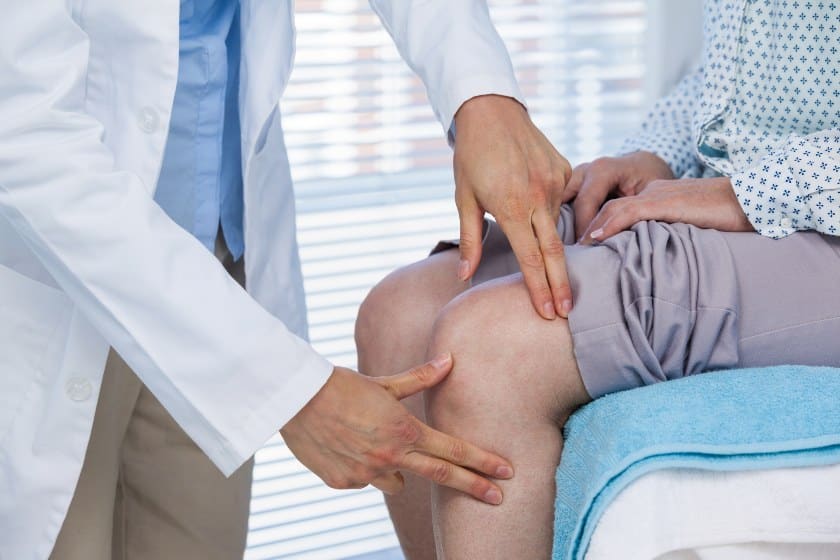
Part of the challenge with recovering from ligament injuries is predicting how long a knee sprain will last.
The recovery time needed for a sprained knee depends on the severity of the injury, how immediate treatment was initiated, age, and overall health status.
Mild sprains, or a Grade 1 injury, may take up to 3-4 weeks to heal.
Partial tears, or a Grade 2 injury, may take up to 6-8 weeks or more to heal.
A complete tear, or a Grade 3 injury, has the possibility to take up to a full year of recovery time, especially if a surgery was involved.
Ultimately, the healing process for a sprained knee will take time, surgery or no surgery. One of the most important things to remember is to address your symptoms as soon as they occur, consult with your healthcare provider right away, and begin the road to rehab!
FAQ:
Can I walk with a sprained knee?
With a mild sprain, continuing to walk is usually fine, as long as it doesn’t cause more pain.
With a partial or complete tear, walking will become more difficult and may require the use of a brace and crutches or a walker for assist.
How soon should I see my doctor after a knee sprain?
If you suspect a mild injury, but a week goes by with no improvement, consult your doctor for an exam.
If you experience more sudden and intense pain at the time of the injury, receive medical attention immediately to have the knee examined right away.
What is the best position to sleep in with a sprained knee?
Try to keep the knee supported as best as possible while sleeping. You can try propping a pillow or two under the leg if you sleep on your back.
If you’re a side sleeper, you can try sleeping with a pillow between the legs.Try to avoid sleeping on the stomach, as this will not provide the best support to the knee.










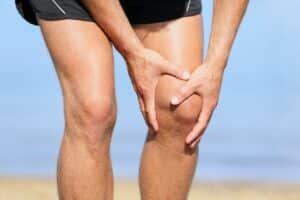
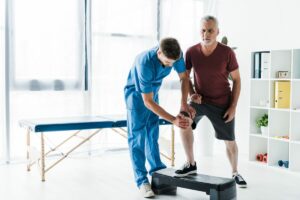

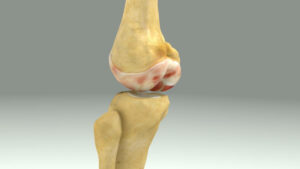


2 Responses
THANK YOU SO MUCH FOR THIS VERY HELPFUL AND TIMELY INFORMATION! My right knee is often in pain. There is most often pain behind the knee in the ligament that activates if I cross my leg over my left knee. Applying pressure while my leg is crossed helps stretch the ligament, but it only lasts as long as I am crossing my leg and applying the pressure. However, sometimes I can just turn the wrong way and a severe catch is triggered and I literally cannot walk with it. But as soon as the locked feeling stops then I'm able to walk again. Well, this happened yesterday. On and off I would alternate feeling locked up or ok to take steps on a level surface. So I will use these exercises tomorrow!
Thank you again! 🙂
Of course, Joanne! I'm excited to hear how these exercises work for you. Please keep us updated, and thank you for reading!